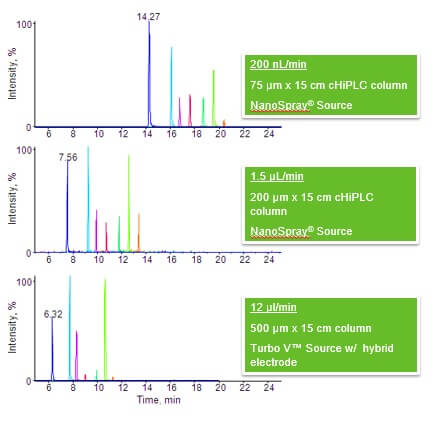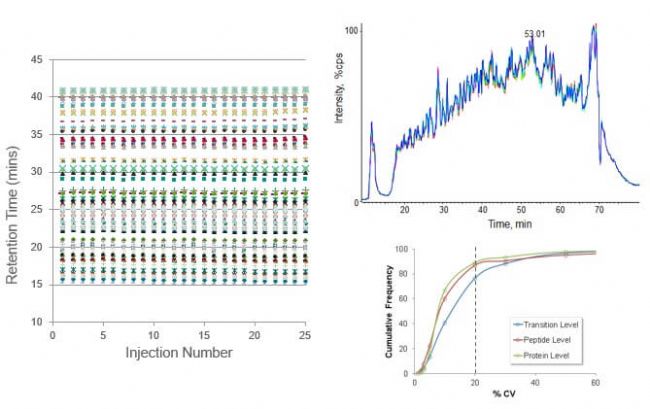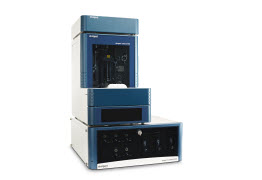1, About NanoLC 400
Developed specifically for nanospray mass spectrometry (MS), our NanoLC systems provide speed, sensitivity, resolution and reliability for your research.
High levels of flow rate flexibility and reproducibility for discovery and targeted proteomics.
2, Specifications
|
Feature
|
nanoLC 400
|
|
Dimensions
|
22” x 26” x 9” (56 x 66 x 23 cm) (W x D x H)
|
|
Weight
|
57 pounds (26 kg)
|
|
Working temperature
|
15°C to 30°C
|
|
Maximum pressure
|
10,000 psi
|
|
Flow rate ranges
|
|
Loading pump
|
1-50 μL/min
|
|
Gradient with nano flow module
|
100-1000 nL/min (up to 2 μL/min at reduced maximum pressure)
|
|
Gradient with low micro flow module
|
1-10 μL/min (up to 20 μL/min at reduced maximum pressure)
|
|
Gradient with high micro flow module
|
5-50 μL/min
|
|
Flow rate accuracy
|
< 1% @ 500 nL/min with nano flow module installed
|
|
Retention time precision
|
< 1% @ 500 nL/min with nano flow module installed and column at constant temperature (± 0.2 °C)
|
|
Gradient delay
|
< 25 nl
|
|
Wetted parts
|
stainless steel, titanium, PEEK, fused silica, FEP
|
|
I/O
|
1 x USB for instrument control each pump channel
2 x TTL in
8 x contact closure out
|
|
Instrument control
|
Eksigent software for stand alone use
Eksigent software with drivers for Analyst software (SCIEX)
and Xcalibur (Thermo) for LC/MS
|
3, Features
1> For research use only. Not for use in diagnostic procedures.
The NanoLC 400 system is the latest generation in NanoLC from SCIEX and offers the widest flow rate range of any SCIEX NanoLC system to date, enabling a diverse collection of workflows on a single low flow LC/MS system. Interchangeable flow control modules enable users to switch effortlessly between nanoflow and microflow applications. Proteomics researchers no longer have to choose between the high sensitivity of Nano-LC/MS and the high throughput of micro-LC/MS. Now one system can be used to move from protein ID and discovery work to higher throughput targeted assays.
With improvements to SCIEX's proven Microfluidic Flow Control, the NanoLC 400 and MFCPlus technology not only enables the simple interchange between different flow rate ranges, but also ensures reliable gradient delivery and reproducible retention times. This is critical for getting the most out of data-independent strategies for quantitative proteomics like SWATH Acquisition on an SCIEX mass spectrometer and any quantitative proteomics workflow.
The NanoLC 400 system is available in single- and dual-gradient configurations in the same compact footprint; and integration with the cHiPLC system and popular mass spectrometry software packages* makes this system a universal front end to almost any nano-LC/MS system, enabling a broad range of workflows for busy multi-user and multi-instrument proteomics laboratories.
*Direct control through SCIEX Analyst software, and Thermo Xcalibur.
2> Switch easily from nanoflow to microflow with interchangeable flow modules

Shorter run times and higher throughput can be achieved using microflow instead of nanoflow. Plug & play modules enable effortless switching, and a faster autosampler supports the move from biomarker discovery to verification assays.
3> Retention time reproducibility

For quantitative proteomics, maintaining retention time reproducibility is crucial.
The latest in SCIEX’s Microfluidic Flow Control technology, MFC Plus™, uses fast flow measurement in combination with automatic feedback to generate accurate and reproducible flow rates without flow splitting. The result is gradient reproducibility typically better than 0.35% at flow rates as low as 100 nl/min.
To achieve the best possible retention time reproducibility, an optional column oven capable of temperatures up to 60°C is available for all nanoLC 400 systems. Elevated temperatures can also be employed to decrease column pressure and improve separation efficiency.
For advanced applications like sample pre-concentration or dual-column set-up, the SCIEX nanoLC 400 autosampler accommodates one or two 10-port nano valves rated at 10,000 psi and have an extremely low port-to-port volume of < 25 nl.
The system’s control software enables users to rapidly create experiments and modify methods. Its method editing wizards and built-in diagnostic tools provide ease-of-use to help maximize uptime.
bio-equip.cn






